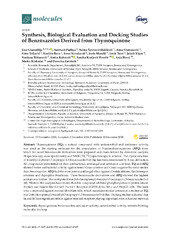Приказ основних података о документу
Synthesis, biological evaluation and docking studies of benzoxazoles derived from thymoquinone
| dc.creator | Glamočlija, Una | |
| dc.creator | Padhye, Subhash | |
| dc.creator | Špirtović-Halilović, Selma | |
| dc.creator | Osmanović, Amar | |
| dc.creator | Veljović, Elma | |
| dc.creator | Roca, Sunčica | |
| dc.creator | Novaković, Irena T. | |
| dc.creator | Mandić, Boris | |
| dc.creator | Turel, Iztok | |
| dc.creator | Kljun, Jakob | |
| dc.creator | Trifunović, Snežana S. | |
| dc.creator | Kahrović, Emira | |
| dc.creator | Pavelić-Kraljević, Sandra | |
| dc.creator | Harej, Anja | |
| dc.creator | Klobučar, Marko | |
| dc.creator | Završnik, Davorka | |
| dc.date.accessioned | 2019-01-09T12:59:41Z | |
| dc.date.available | 2019-01-09T12:59:41Z | |
| dc.date.issued | 2018 | |
| dc.identifier.issn | 1420-3049 | |
| dc.identifier.uri | https://cherry.chem.bg.ac.rs/handle/123456789/2807 | |
| dc.description.abstract | Thymoquinone (TQ), a natural compound with antimicrobial and antitumor activity, was used as the starting molecule for the preparation of 3-aminothymoquinone (ATQ) from which ten novel benzoxazole derivatives were prepared and characterized by elemental analysis, IR spectroscopy, mass spectrometry and NMR (1H,13C) spectroscopy in solution. The crystal structure of 4-methyl-2-phenyl-7-isopropyl-1,3-benzoxazole-5-ol (1a) has been determined by X-ray diffraction. All compounds were tested for their antibacterial, antifungal and antitumor activities. TQ and ATQ showed better antibacterial activity against tested Gram-positive and Gram-negative bacterial strains than benzoxazoles. ATQ had the most potent antifungal effect against Candida albicans, Saccharomyces cerevisiae and Aspergillus brasiliensis. Three benzoxazole derivatives and ATQ showed the highest antitumor activities. The most potent was 2-(4-fluorophenyl)-4-methyl-7-isopropyl-1,3-benzoxazole-5-ol (1f). Western blot analyses have shown that this compound inhibited phosphorylation of protein kinase B (Akt) and Insulin-like Growth Factor-1 Receptor (IGF1R β) in HeLa and HepG2 cells. The least toxic compound against normal fibroblast cells, which maintains similar antitumor activities as TQ, was 2-(4-chlorophenyl)-4-methyl-7-isopropyl-1,3-benzoxazole-5-ol (1e). Docking studies indicated that 1e and 1f have significant effects against selected receptors playing important roles in tumour survival. | |
| dc.publisher | MDPI | |
| dc.relation | Research Infrastructure for Campus-based Laboratories at University of RijekaResearch Infrastructure for Campus-based Laboratories at University of Rijeka | |
| dc.rights | openAccess | |
| dc.rights.uri | https://creativecommons.org/licenses/by/4.0/ | |
| dc.source | Molecules | |
| dc.subject | Anticancer activity | |
| dc.subject | Antimicrobial activity | |
| dc.subject | Benzoxazoles | |
| dc.subject | Molecular docking | |
| dc.subject | Thymoquinone | |
| dc.subject | Western blotting | |
| dc.title | Synthesis, biological evaluation and docking studies of benzoxazoles derived from thymoquinone | |
| dc.type | article | en |
| dc.rights.license | BY | |
| dcterms.abstract | Вељовић, Е.; Мандић, Б.; Кахровић, Е.; Павелић, С.К.; Хареј, A.; Клобучар, М.; Завршник, Д.; Новаковић, И.; Турел, И.; Кљун, Ј.; Трифуновић, С.; Роца, С.; Гламочлија, У.; Падхyе, С.; Шпиртовић-Халиловић, С.; Османовић, A.; | |
| dc.citation.volume | 23 | |
| dc.citation.issue | 12 | |
| dc.identifier.wos | 000454523000247 | |
| dc.identifier.doi | 10.3390/molecules23123297 | |
| dc.citation.rank | M22 | |
| dc.description.other | Supplementary material: [http://cherry.chem.bg.ac.rs/handle/123456789/3004] | |
| dc.type.version | publishedVersion | |
| dc.identifier.scopus | 2-s2.0-85058766907 | |
| dc.identifier.fulltext | https://cherry.chem.bg.ac.rs/bitstream/id/6427/molecules-23-03297.pdf |


